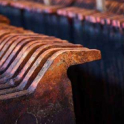Our production advantages
Stages of cable production

Cable production begins with the collection of copper scrap. This can be old cable equipment, spent copper wire and other waste from the copper industry.

Copper refining involves fire refining where the copper is melted in a furnace and exposed to high temperatures to remove various impurities. This process improves the quality of the copper and helps achieve greater purity. Anodes are the result of fire refining.

After refining, the anodes are immersed in a special solution. In the process of electrolysis, copper settles on the cathodes, and other metals settle to the bottom of the solution in the form of sludge. Only electrolysis helps to obtain copper of high purity >99.99%, which is necessary for the production of high-quality cables.

At this stage, the cathode is melted and cast as long copper blanks. This process forms the structure of the copper wire and determines its diameter. The result of casting is wire (or wire rod)

The wire obtained as a result of vertical casting is subject to rough drawing. This is the process of making copper wires of a smaller diameter (than wire rod) by drawing them through special dies. This is how copper wire for class 1-2 cable is obtained.

The wire obtained after coarse drawing undergoes fine drawing, where it is again drawn through dies of even smaller size. This is how copper wire for class 3-5 cable is obtained.

The final stage is extrusion, where a special insulating material is applied to the copper wire to provide electrical insulation and protection from external factors.
Our production advantages

SCRAP
Copper quality control begins with the receipt and screening of scrap of unsuitable quality.

ANODE
Obtaining anodes is the result of the second stage in the cable production cycle, and is an important element for copper purification.

CATHODE
The main advantage of ZZKM cable is cathodes, namely, the method of obtaining them is electrolysis. It is electrolysis that makes it possible to obtain copper with an ideal chemical composition. Other cable plants skip this stage and obtain wire by simply remelting scrap into copper wire.

ROD
Cathodes are melted and cast to form a rod - a long copper billet that will be used for further drawing and wire production.

WIRE
Wire rod is subjected to a rough and fine drawing process to create copper wire. This wire will be used to create the cores in the cable.

Core
After fine drawing, the wire is processed and twisted into a core (many thin copper wires twisted into one) which is the main conducting part of the copper cable.

Cable
The core is insulated by extrusion (insulation and sheathing) where the wire is covered with an insulating material. The result of this process is a ready-made copper cable intended for the transmission of an electrical signal in electrical and electronic systems.
The absence of fire refining, electrolysis and vertical casting leads to the fact that the cable has more impurities and has a worse electrical resistance for the same core diameter, compared to the ZFNM cable. In addition, it becomes heavier and less flexible, which is directly felt during installation.





